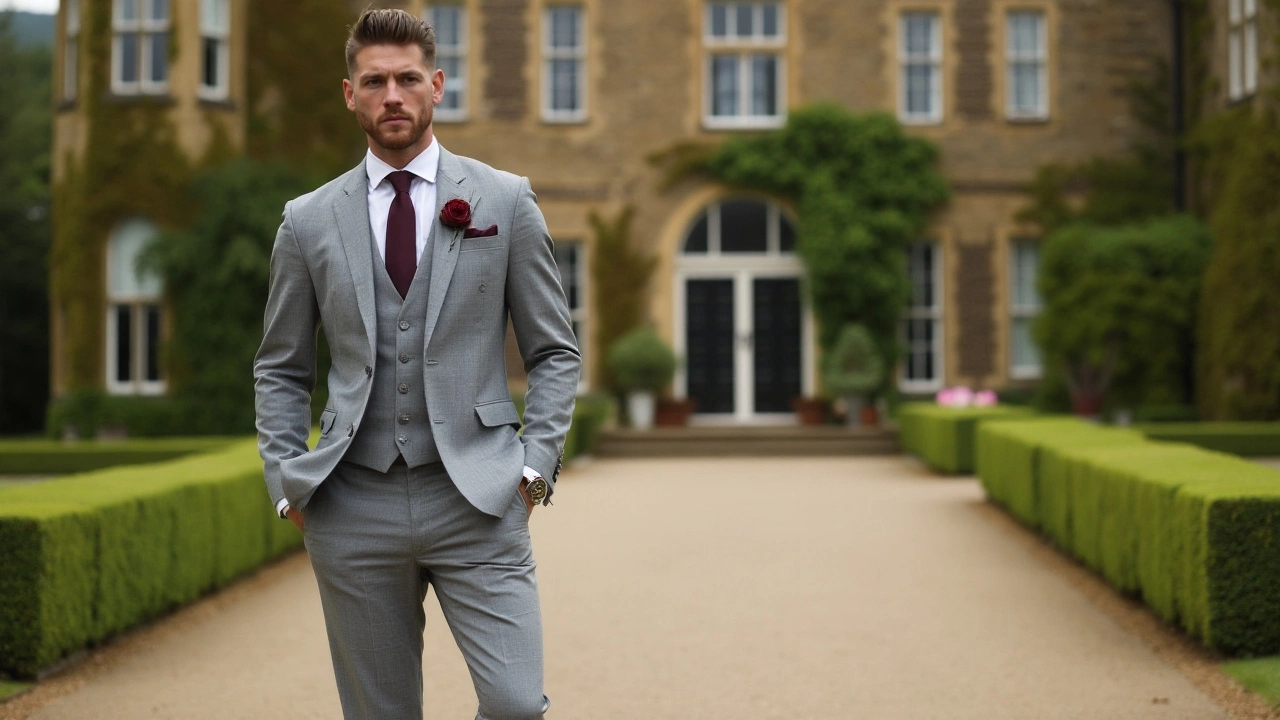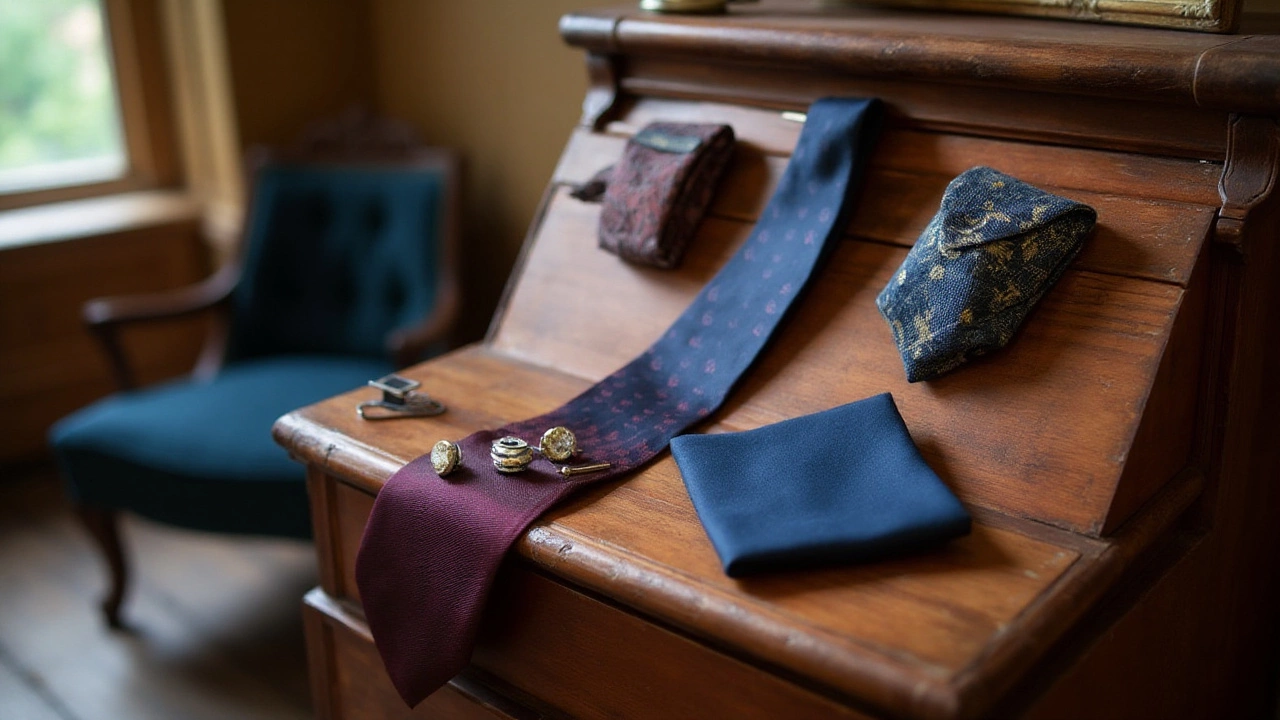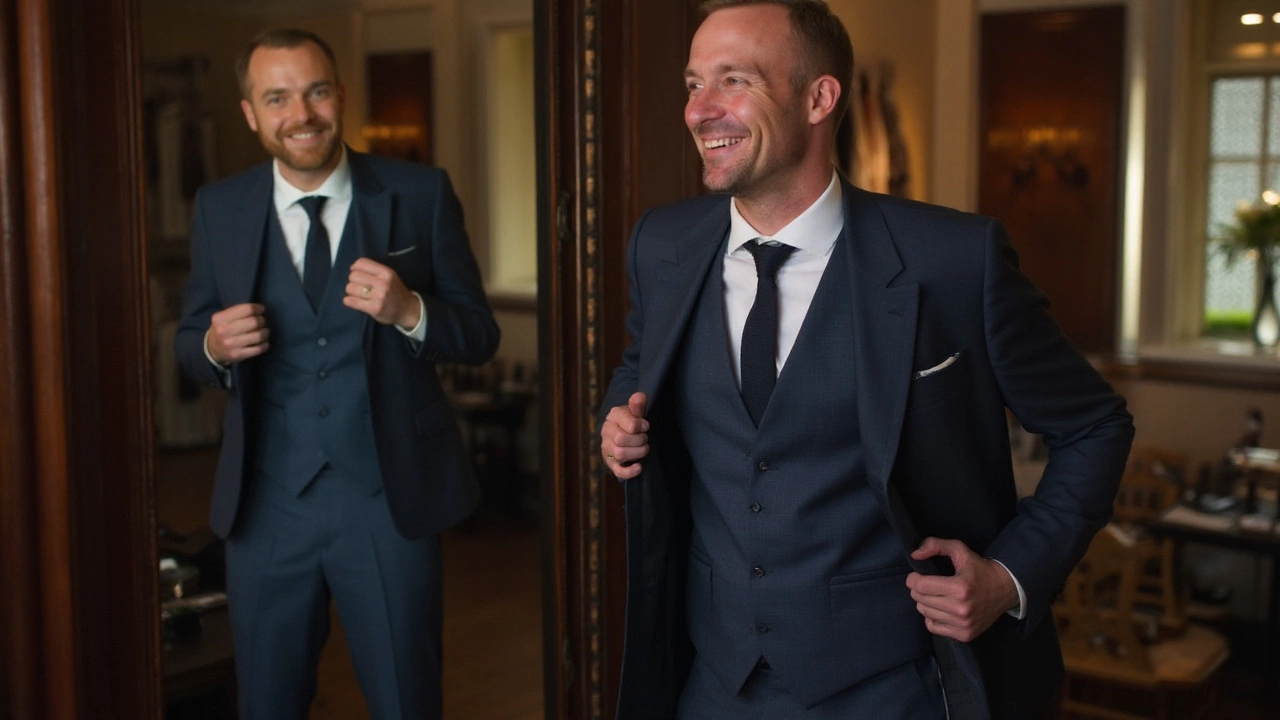Every groom wants to feel and look his absolute best on the wedding day, and choosing the right suit plays a significant role in achieving this. A well-fitted suit can enhance your appearance, making you look polished and confident, while a poorly chosen one can do the opposite.
Fortunately, you don't need to be an expert tailor to find a suit that complements your figure. By focusing on key elements such as fit, fabric, cut, color, and accessories, you'll be able to select a suit that not only fits you well but also flatters your physique.
Let's dive into these essential aspects of suit selection, ensuring that what's worn on the outside reflects the joy and excitement felt within.
- Understanding Fit and Fabric
- Choosing the Right Suit Cut
- Colors and Patterns That Flatter
- Accessorizing for a Balanced Look
Understanding Fit and Fabric
Groom suits are made to make you appear sharp and sophisticated on your special day. The most crucial aspect of choosing the right suit is its fit, which can vastly alter how a suit looks on your body. A poorly fitted suit often looks clumsy and bulky, drawing attention to areas you'd rather deemphasize. Typically, you want a fit that compliments your shape without being too tight or too loose. A good starting point is choosing between different fits such as slim, modern, or classic, which vary in tightness and structure. Each provides unique benefits and may work better with different body types. Did you know that a tailored fit could make you appear up to 10 pounds lighter instantly by just settling correctly across the shoulders and waist?
Equally important is the fabric of the suit. Different materials drape and hang differently on the body, altering appearance significantly. Wool is a staple choice and comes in various weights that can be adapted to seasons and conditions. For those looking for something lighter, cotton or linen may be attractive options, especially for summer weddings. These materials allow more breathability but can wrinkle easily, so they require careful consideration. Alternatively, modern blends often provide the look of wool with added flexibility and comfort. A fascinating fact is that skillfully selected fabric can guide the eye and create longer, cleaner lines, enhancing the overall stature. Pay attention to patterns too—a pinstripe can elongate the body, where horizontal patterns may widen it.
The Role of Tailoring
Tailoring transforms a suit from average to outstanding. It's no mystery why bespoke suits, which are custom made according to one's precise measurements, are heralded in fashion history. An off-the-rack suit can be an excellent choice, but spending a bit on alterations by a professional could be a game changer. Ensuring your suit hugs the frame appropriately at the shoulders and chest while still providing room to move will do wonders. Adjustments such as pant length and waist fitting cannot be ignored—these elements contribute significantly to the final look. A general rule is the shirt cuffs should extend half an inch beyond the suit over the wrist, offering a sleek window of shirt visibility."Dress in a way that suits your build. If it means investing in a mid-range suit and having it precisely tailored, do it. It'll pay off a thousand fold," recommends renowned fashion consultant Tim Gunn.
Fabric and fit don't only impact looks; they influence comfort and confidence too. There's a direct link between how clothing feels and how it affects your posture and poise. Choose quality material—it tends to sustain structure, maintaining its appearance throughout the day. Remember, a well-fitted suit doesn't mean a restrictive suit; movement is essential, especially on a day full of greetings and dancing. Evaluate if you can comfortably sit and bend before finalizing—that’ll ensure no unwanted surprises on your big day.

Choosing the Right Suit Cut
When it comes to selecting the ideal suit, one of the primary considerations is the suit cut, which can make all the difference in achieving a sleek and slim fit look. The fit of the suit refers not only to the overall silhouette but also to how the garment sits on the body—hugging it in all the right places without feeling restrictive. A well-fitted suit should highlight your best features while subtly reducing or deemphasizing areas you might feel less confident about. Common suit cuts include slim, tailored, and classic fits, each offering distinct advantages.
The slim fit suit cut is particularly popular among those seeking a modern, sharp appearance. Tailored close to the body, it offers a snug fit through the chest and waist, giving the wearer a streamlined look. Yet, it's important to ensure this fit is proportional to your body type. A suit that's too tight can lead to discomfort, while too loose a fit may result in that unwanted bulky appearance. Balancing these elements is indeed key, and sometimes seeking the guidance of a professional tailor can provide a custom touch that off-the-rack suits lack.
For those who prefer a more traditional look, the classic fit might be the way to go. The classic cut often features a more relaxed frame, which may be favorable for those with a broader build or for those who prioritize comfort. While this fit is looser than the slim fit variety, it still ensures sophistication when worn correctly. Opting for a classic fit doesn't mean one sacrifices style; rather, it means the emphasis is on timeless elegance rather than modern trends. Pairing a classic cut with the right accessories can add contemporary flair without detracting from comfort.
Another viable option is the tailored fit, which sits between the slim and classic cuts. It provides a perfect balance for those who might find slim fits overly tight and classic fits too loose. The tailored fit contours the body without being restrictive, offering a stylish middle ground. Always remember, the precise selection of suit cut is crucial to maintaining a groom's appearance and comfort throughout their wedding day. As fashion expert Tom Ford once mentioned,
"Dressing well is a form of good manners."Hence, ensuring that the suit's cut aligns with both personal taste and comfort is essential.
While choosing the right cut, remember to consider the components of a suit: the jacket, trousers, and often the vest. Each part plays a role in creating the overall look. For example, ensure jacket sleeves and hem are at an appropriate length to maintain the visual line of your outfit. The jacket’s shoulders should sit naturally, not wider or narrower than your own shoulders, which maintains the structural integrity of the garment. Meanwhile, trousers should have an appropriate length that breaks slightly at the shoe top, ensuring a polished look from head to toe. Attention to these individual components leads to an effortlessly elegant appearance on any grand occasion, especially for wedding attire where every detail is magnified.
In summary, selecting the right suit cut involves more than just picking what looks good on the mannequin. It's about understanding your body and how different fits work with its unique shape. Considering trends, personal taste, and comfort levels will help you choose a suit that not only looks fabulous but also feels amazing, ensuring you look your best on one of the most significant days of your life.

Colors and Patterns That Flatter
Choosing the right colors and patterns for a suit can significantly impact the way a groom looks on his wedding day. It's not just about preference; certain shades and designs can enhance one’s physique, creating a sleeker, more streamlined appearance. When picking out a suit, it's essential to consider how different colors interact with natural body shapes and sizes. Darker hues, such as navy blue, charcoal, and classic black, often create an illusion of slenderness by absorbing light rather than reflecting it. This trick of the eye makes these colors a go-to choice for those looking to present a more refined silhouette. Slim fit suits in these shades are particularly effective, as they hug the body's natural lines without adding unnecessary bulk.
Patterns, when chosen carefully, can also play a role in how a suit flatters the wearer. Vertical stripes are perhaps the most well-known option for those wanting to add a sense of height or diminish width. They draw the eye up and down rather than side to side, creating a lengthening effect. However, subtlety is key; too bold a stripe can become overwhelming and have the opposite effect. On the other hand, checks and plaids should be approached with caution. While they can offer a classic, timeless look, large-scale patterns can add visual width. If you're fond of these designs, opt for tighter, smaller checks that won't overshadow your frame.
It's also fascinating to realize the psychological impact colors can have on one's perception. Blue, for instance, is often associated with calmness and confidence. On a day where emotions may run high, donning a suit in this shade might lend an air of collected poise. Fabrics like wool and twill that hold dyes well can make colors appear more solid and vivid, further elevating this effect. In terms of seasonal choices, consider lighter fabrics in warmer months to maintain comfort without sacrificing style. Creative color usage, such as a soft grey or brown for a daytime wedding, can be refreshing while still ensuring a touch of sophistication.
"Wearing the right color combination can substantially enhance your ensemble, offering just the perfect balance between subtlety and assertive elegance," notes fashion consultant Mark Simmons.
In crafting the perfect look, don't underestimate the significance of accessories. A dark tie or pocket square can punctuate an ensemble, bringing attention inwards and upwards. This visual centering can again add to the illusion of height and make the wearer appear more statuesque. Accessories also offer a chance to incorporate patterns and colors that would be overwhelming if used for the entire suit. For instance, a pin-striped tie paired against a solid shirt provides a harmonious balance that is both modern and flattering. Thinking of ways to integrate splashes of color, such as a boutonniere that compliments the suit, ensures that every component of the outfit works together seamlessly.
Remember, while trends may dictate what’s popular, ultimately, a suit should reflect the groom's personal style and comfort. The right combination of color and pattern can transform a simple suit into a masterpiece of sartorial elegance, ensuring the groom looks stunningly poised and impeccably dressed on this momentous occasion. Embracing these subtle yet powerful guidelines can lead to a truly memorable wedding day outfit.

Accessorizing for a Balanced Look
Choosing the right accessories can significantly impact how you look in your wedding suit, helping to create an appearance that feels both elegant and proportionate. It's all about finding the balance that suits your style and body type. To start, consider the size and shape of your accessories. Larger-framed individuals may find that chunkier ties and broader lapels provide a harmonious look by mirroring their build. On the flip side, slender grooms might opt for slimmer ties and narrower lapels to maintain a cohesive aesthetic.
Color and pattern coordination is equally vital. Accessories should complement, not overshadow your suit. For instance, a classic navy or charcoal suit paired with a crisp white shirt serves as a versatile canvas that can handle a pop of color or subtle pattern in your tie and pocket square. Experts suggest that fewer than three colors in your entire ensemble keep the look unified. When it comes to patterns, mixing too many, such as stripes with checks, can be overwhelming. A good rule is to vary the scale; if your suit has a bold pattern, go for a subtle tie and vice versa.
"Accessories are like spices – they enhance the overall flavor of clothing, making each outfit unique without overpowering it," says renowned stylist Tim Gunn.
Beyond ties and pocket squares, consider the impact of cufflinks, watches, and shoes. While often overlooked, these elements can introduce texture and interest. Cufflinks, in particular, offer a fantastic opportunity to inject personality, whether that's through a simple metallic sheen or something more distinct, such as an engraved design. Similarly, your choice of watch can say a lot about your style, blending traditional elegance or modern minimalism. Shoes should mirror the formality of the suit; a polished pair of Oxfords or brogues in brown or black works well for most formal suits.
Incorporating belts and cummerbunds requires careful thought because these can either divide or elongate your silhouette. A belt that contrasts starkly with your trousers might break up the visual line of your outfit, so matching the belt to the suit color creates a more continuous look. Meanwhile, vests or waistcoats offer layering options that can enhance the impression of height and add warmth. Groom suits are not just about the fabric; they are about the story each element tells when pieced together.
For those wanting to take their accessorizing to the next level, personalization is key. Consider monogramming shirts, cuffs, or even the interior of the suit jacket. It's these little touches that bring a sense of luxury and individuality, ensuring that your wedding day attire represents not just style, but also personal values. Remember, your choices should reflect who you are while also considering the formality of the occasion.
